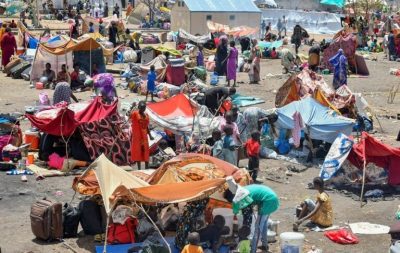New Nations: California

Image courtesy of Wikipedia.
1,284 words
Talk of secession usually focuses on red states, but it can also apply to blue states, perhaps even more so. This is because Republican politicians have generally proven to have less political willpower than Democrats, so a Republican administration is less likely to be willing or able to stop a blue state from breaking off.
Although they rarely follow through, it is common for liberals to claim that they will move to Canada if a Republican wins the presidency. If they are willing to entertain the idea of moving to a foreign country because of politics, even if mostly in jest, becoming their own country is not that far-fetched by comparison.
California is the most likely blue state to secede. Indeed, there is already an active Left-wing “Calexit” movement. Due to its size and a number of conservative enclaves such as Orange County and rural Northern California, there is a question of whether California would break off as a single unit, as multiple nations, or perhaps resolve the question county by county. For example, YesCalifornia proposes a “Calexit 3.1” in which the coastal region around the Bay Area breaks off as the sovereign nation of Pacifica, with the rest of California remaining in the United States.[1]
While California under this plan would still be majority Democrat at 59%, this is a lot less than the 75% of Democrats in Pacifica. Along with being fewer in number, it is likely that the Democrats in California would be less extreme than in deep-blue Pacifica. It is possible that a libertarian-adjacent consensus would emerge in California’s internal state politics once the Pacifica radicals are no longer part of the equation, which would reduce polarization and gridlock. Under this plan, California’s reliably Democrat electoral college votes would drop from 54 to 40 or 41. The House of Representatives would also see a drop in deep-blue Congressional districts.
While YesCalifornia’s Calexit 3.1 proposal is interesting, let’s examine what California would look like if it broke off entirely as either a single state, or if the rest of California broke off alongside Pacifica as a second sovereign nation.
What would an independent California look like?
California has a rich and exciting history: the Spanish missions, the Gold Rush, Hollywood, and surf culture.
California is 163,696 square miles in size, with a population of 38.9 million and a Gross Domestic Product of $3.598 trillion. In a ranking of 195 recognized sovereign states, an independent California would rank:
- 90th in size. For comparison, Uruguay would be 89th in size, and Suriname would be 91st in geographic size.[2]
- 37th in population. For comparison, Canada would be 36th and Poland at 38th in population[3]
- 5th in GDP, between Japan at 4th and India at 6th.[4]

You can buy Greg Johnson’s Against Imperialism here.
After losing California, the US would still rank at 4th in size, 3rd in population, and even 1st in GDP despite losing 14.7% of its GDP.[5]
There is an issue of how California’s departure would affect the balance of power in the Electoral College and Congress. Currently, California has 54 out of 538 winner-take-all electoral college votes which are reliably Democrat. California provides two reliably Democratic senators. Of California’s 52 Congressional representatives, 40 are currently Democrats and 11 are Republicans, with one vacancy.[6]
California leaving the Union would be a cause for liberals in California to rejoice, as they would be liberated from a conservative Supreme Court and the possibility of a Republican presidency. Conservatives in the remaining United States would also enjoy a minor tilt in the balance of power to their favor if Pacifica left, and a major tilt if all of California left. However, conservatives in California would naturally be concerned if California would swiftly change into a Leftist dystopia such as Canada or the United Kingdom, while liberals in the remaining US would naturally be concerned about the shift in the electoral balance of power.
The concerns of liberals in the remaining United States could be mitigated by allowing Texas to break off alongside California. (What an independent Republic of Texas would look like has been discussed elsewhere.) This would be similar to the way in which free states and slave states had to be added in pairs to maintain the balance of power in the early nineteenth century. A gradual National Divorce in which red and blue states break off in pairs of states which are roughly comparable to one another would facilitate support from both parties.
The Republican enclaves in California could be granted autonomy to assuage their concerns. There is already a precedent for this with liberal “sanctuary cities” refusing to enforce immigration laws and California legalizing marijuana, despite the fact that this is a blatant violation of federal law. There is no reason why conservatives can’t make use of this same tactic and create sanctuary regions for gun rights, although this arrangement should be officially recognized to avoid betrayal. And the existence of liberal enclaves in Republican nations would provide an incentive for both sides to reciprocate in respecting the rights and customs of their political minorities.
California’s economy would largely be based on technology. For example, Apple, Nvidia, and Blizzard Entertainment are headquartered in California. Eleven of the Fortune 100 companies and 53 of the Fortune 500 companies are headquartered in California.[7] California is also home to Hollywood and the film industry, for better or for worse. California has some of the largest ports in America, with Long Beach being the sixth-busiest in cargo volume nationally and Los Angeles the ninth-busiest.[8]
But despite being only a sliver of its GDP, California’s greatest strategic strength is its agricultural sector, which has the highest output of any state, growing over half of America’s fruits, vegetables, and nuts.[9] Because 40% of California’s water consumption goes toward its agricultural sector, however, this strength leads into California’s greatest weakness, which is water.
Water has been a critical weakness and source of conflict since California’s earliest days. For example, Mulholland’s titanic aqueduct project allowed Los Angeles county to bloom, but at the expense of the wholesale exploitation and destruction of the Owens Valley’s water resources .[10] Much of California’s water supply comes from its northern mountains, and is transported to its drier but more populous southern regions. Additionally, about 25% of southern California’s water comes from the Colorado River, which originates in Wyoming and Colorado and then passes through and drains portions of Utah, New Mexico, Arizona, and Nevada.[11][12]
This weakness is not insurmountable. While the threat of the United States turning off California’s water supply could provide great leverage against California, California also has great leverage against the United States with its exports of fruits, vegetables, and nuts. An escalating water dispute would lead to the mutually assured destruction of both side’s economies, so there is a strong incentive to cooperate. Furthermore, the Nile shows that nations can cooperate in sharing a river. Despite the Nile basin including the Democratic Republic of the Congo, Tanzania, Burundi, Rwanda, Uganda, Kenya, Ethiopia, Eritrea, South Sudan, Sudan, and Egypt, the Nile has been marked more by cooperation than competition.
Demographically, California was only 34.7% non-Hispanic white as of 2020, so allowing California to break off would help slow the Great Replacement in the remaining United States.[13]
In 2018, California provided the federal military the largest number of troops.[14] California is also home to 32 military bases, including several highly important ones.[15] There is no doubt that California could defend itself. Furthermore, California could have a NATO-style military pact with the United States and/or its other successor states.
California has more than ample resources to survive as an independent nation. Whether those resources would be used wisely is another question. But if used unwisely, California would have nobody else to blame but themselves.
Notes
[1] https://www.yescalifornia.org/
[2] https://en.wikipedia.org/wiki/List_of_countries_and_dependencies_by_area
[3] https://en.wikipedia.org/wiki/List_of_countries_and_dependencies_by_population
[4] https://en.wikipedia.org/wiki/List_of_countries_by_GDP_(nominal)
[5] https://en.wikipedia.org/wiki/List_of_U.S._states_and_territories_by_GDP
[6] https://ballotpedia.org/United_States_congressional_delegations_from_California
[7] https://en.wikipedia.org/wiki/Economy_of_California
[8] https://en.wikipedia.org/wiki/List_of_ports_in_the_United_States
[9] Ibid., see also https://en.wikipedia.org/wiki/Agriculture_in_California
[10] https://www.americanheritage.com/water-war
[11] https://www.nature.org/media/california/california_drinking-water-sources-2012.pdf
[12] https://rebuildsocal.org/southern-ca-tap-water/
[13] https://en.wikipedia.org/wiki/Demographics_of_California
[14] https://worldpopulationreview.com/state-rankings/military-members-by-state
[15] https://militarybases.com/california/


